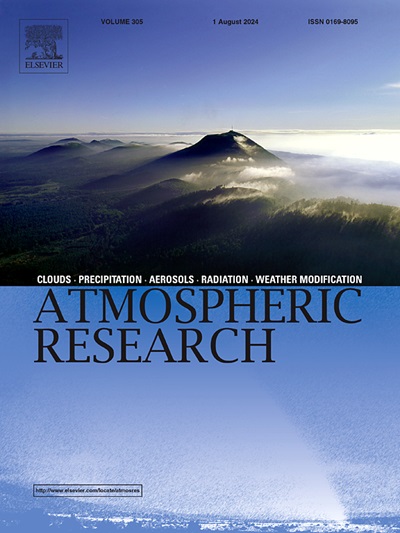青藏高原东北部祁连山地貌降水环流特征数值模拟
IF 4.5
2区 地球科学
Q1 METEOROLOGY & ATMOSPHERIC SCIENCES
引用次数: 0
摘要
为了阐明青藏高原东北部(简称青藏高原)山地降水的同步气象学和低空环流特征,本文利用天气研究与预报(WRF)模式对2019年8月12-13日发生在祁连山的降水案例进行了数值模拟。结果表明,WRF 模式能够大致捕捉到此次山地降水的时间和位置。在此期间,主要由于复杂地形在高空提供有利环流背景的影响,在500 hPa大尺度低槽的初始和持续阶段,低槽后方出现了一个弱槽和一个弱脊。这种环流模式的消失和大尺度槽后的西北风导致了降水的消失。本文章由计算机程序翻译,如有差异,请以英文原文为准。
Numerical simulation of circulation characteristics of orographic precipitation in Qilian Mountains, Northeastern Tibetan Plateau
In order to clarify the synoptic meteorology and low-level circulation characteristics of orographic precipitation in northeastern Tibetan Plateau (referred as TP), numerical simulation of a precipitation case that happened in Qilian Mountains on August 12–13, 2019 was conducted using the Weather Research and Forecasting (WRF) model in this paper. The results show that WRF model can roughly capture the timing and location of the orographic precipitation. During the period, a weak trough and a weak ridge were found behind a large-scale trough at 500 hPa at the initial and continuation phases primarily due to the effect of complicated topography to provide a beneficial circulation background at high altitudes. The extinction of this circulation pattern and northwesterly after the large-scale trough leaded to the extinction of the precipitation.
In lower levels, warm advection from the south and cold advection from the north met over the precipitation region, resulting to a dividing temperature line tilting northeast from surface to high-altitude, which was crucial for instability and humidity, although no significant converging wind field near the surface suffering from the complex topography. In addition, the low-level jet, downslope flow and heating role at the basin bottom were also found to play important roles in the precipitation. The above analysis indicates that the precipitation was a result under the combined influence of the westerly circulation and the plateau monsoon circulation.
求助全文
通过发布文献求助,成功后即可免费获取论文全文。
去求助
来源期刊

Atmospheric Research
地学-气象与大气科学
CiteScore
9.40
自引率
10.90%
发文量
460
审稿时长
47 days
期刊介绍:
The journal publishes scientific papers (research papers, review articles, letters and notes) dealing with the part of the atmosphere where meteorological events occur. Attention is given to all processes extending from the earth surface to the tropopause, but special emphasis continues to be devoted to the physics of clouds, mesoscale meteorology and air pollution, i.e. atmospheric aerosols; microphysical processes; cloud dynamics and thermodynamics; numerical simulation, climatology, climate change and weather modification.
 求助内容:
求助内容: 应助结果提醒方式:
应助结果提醒方式:


